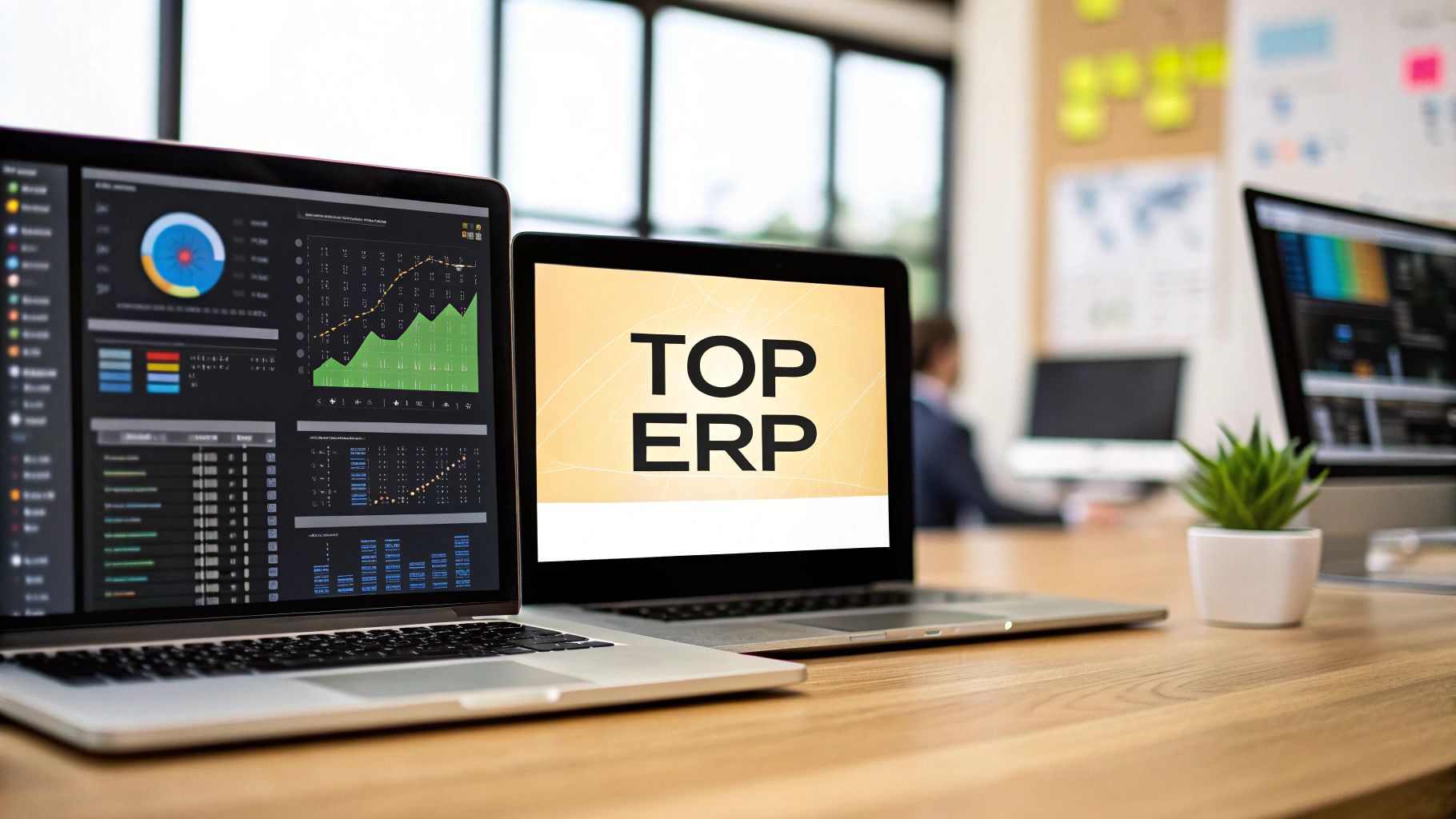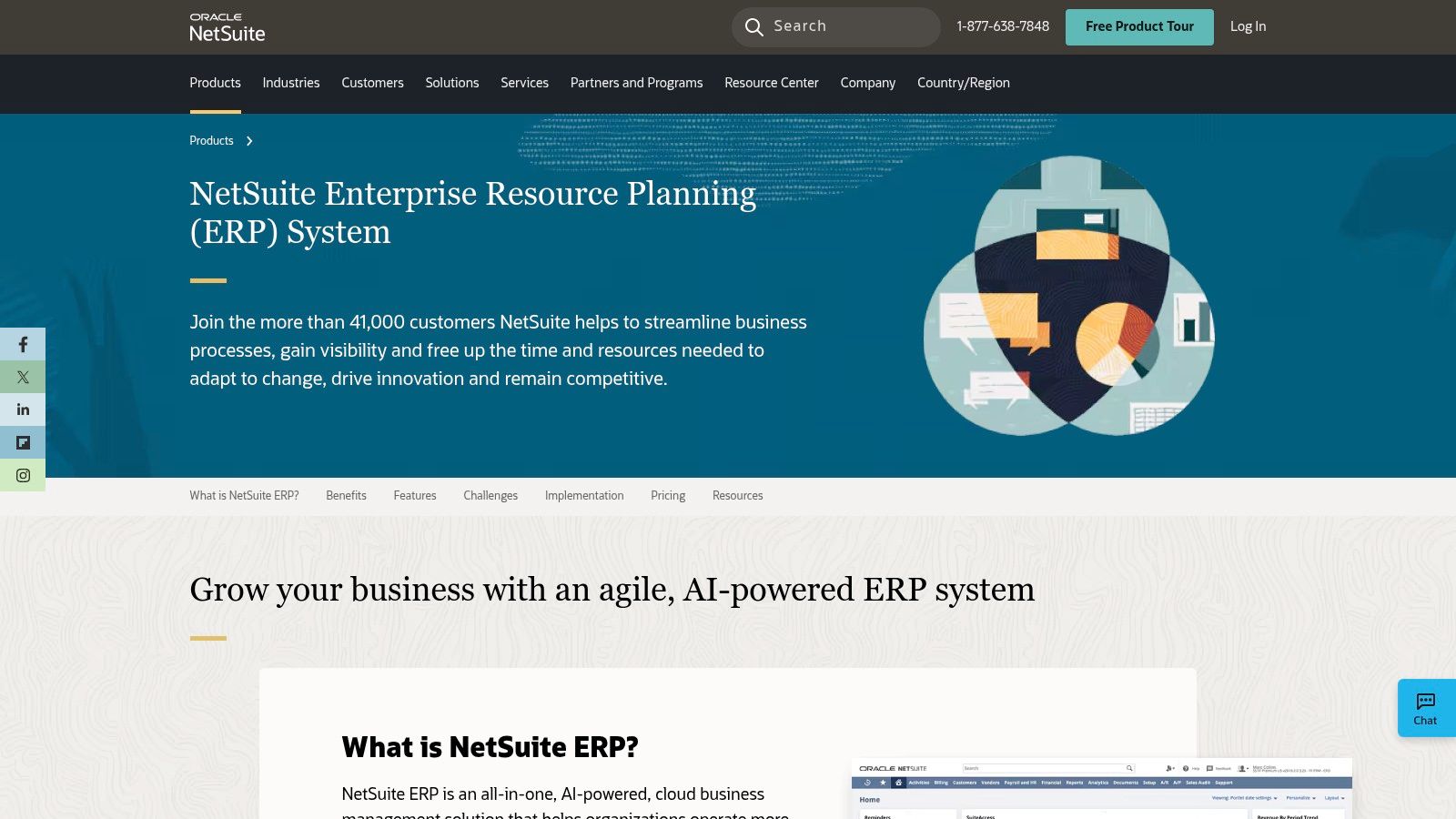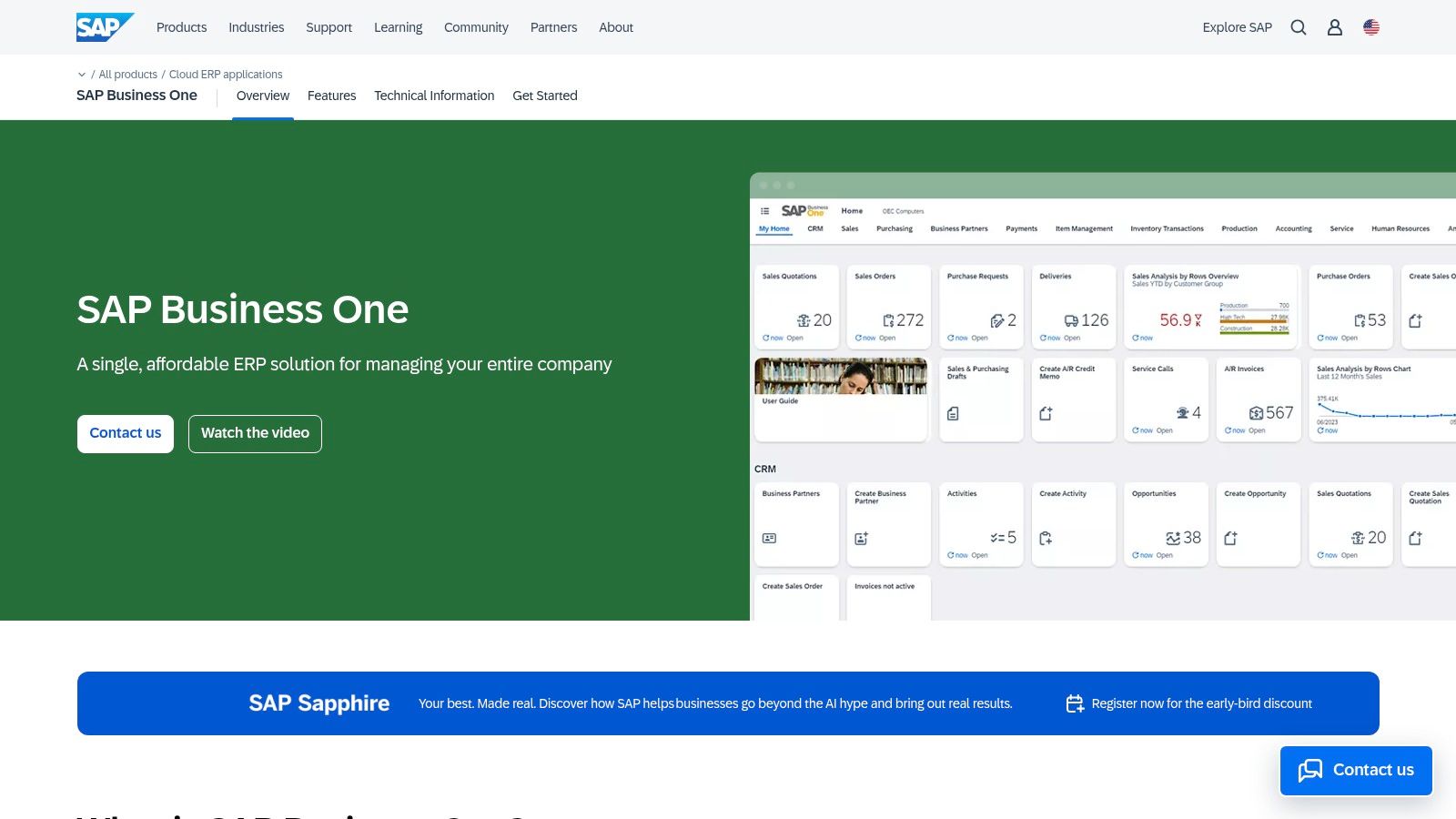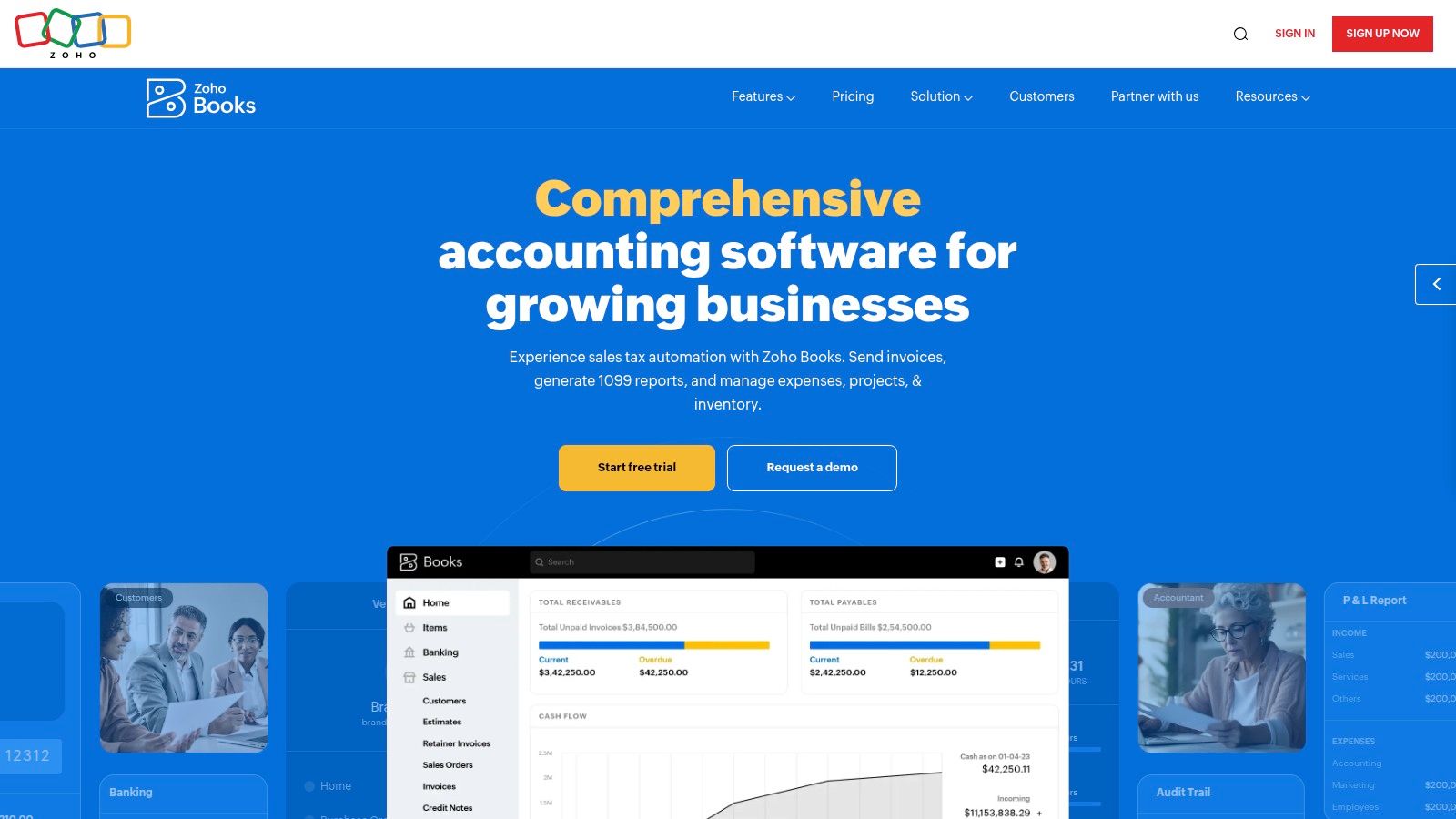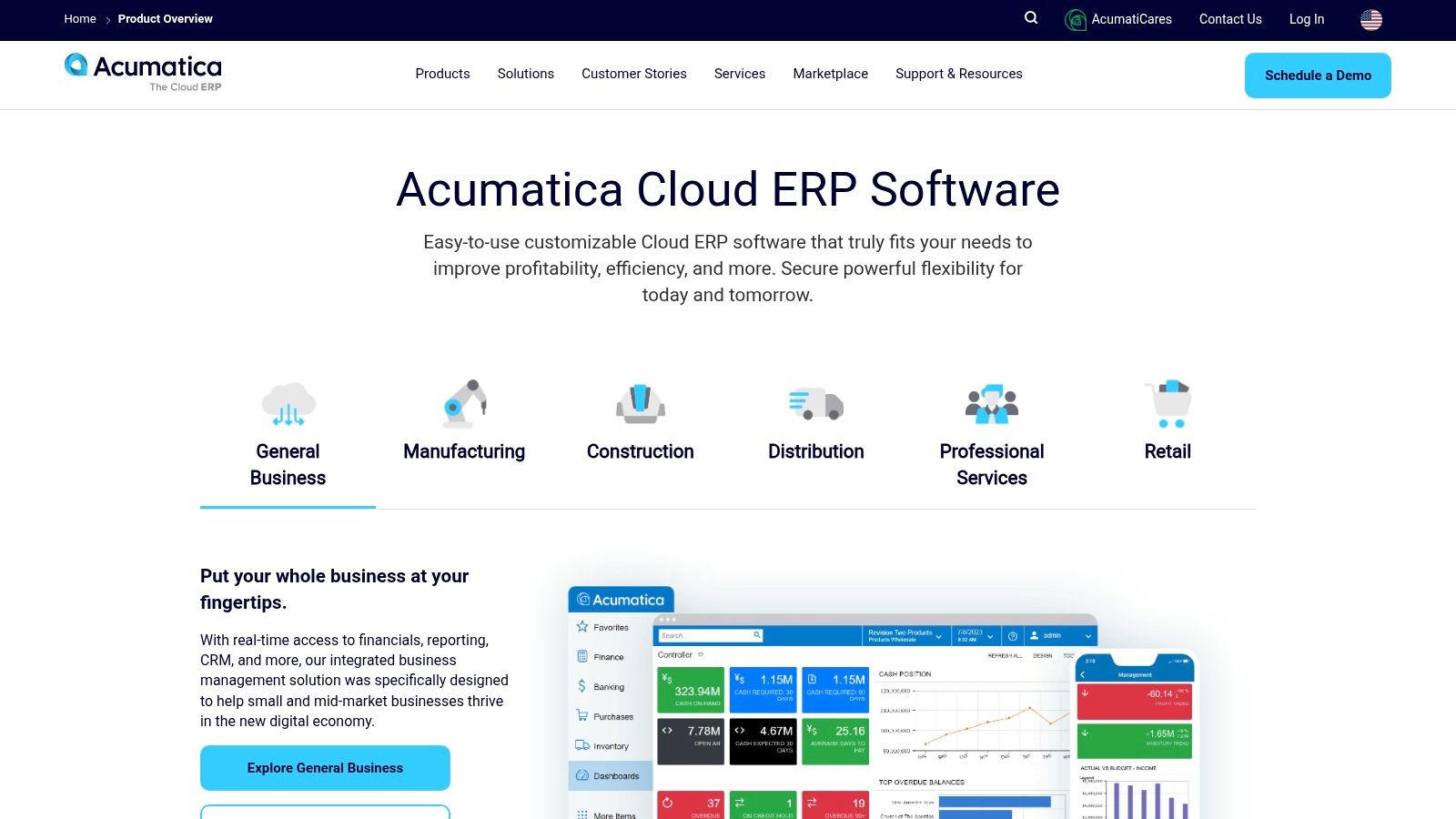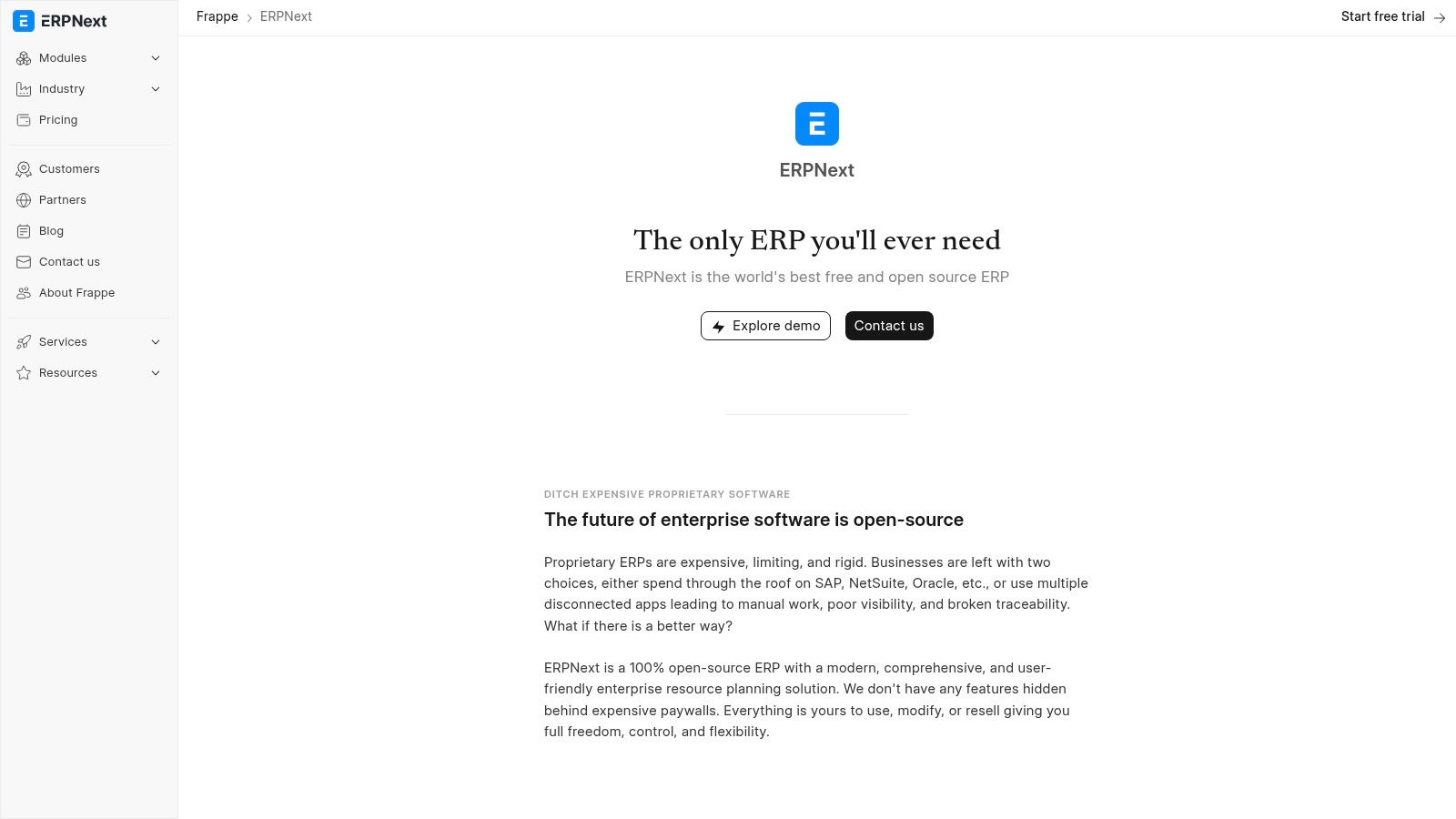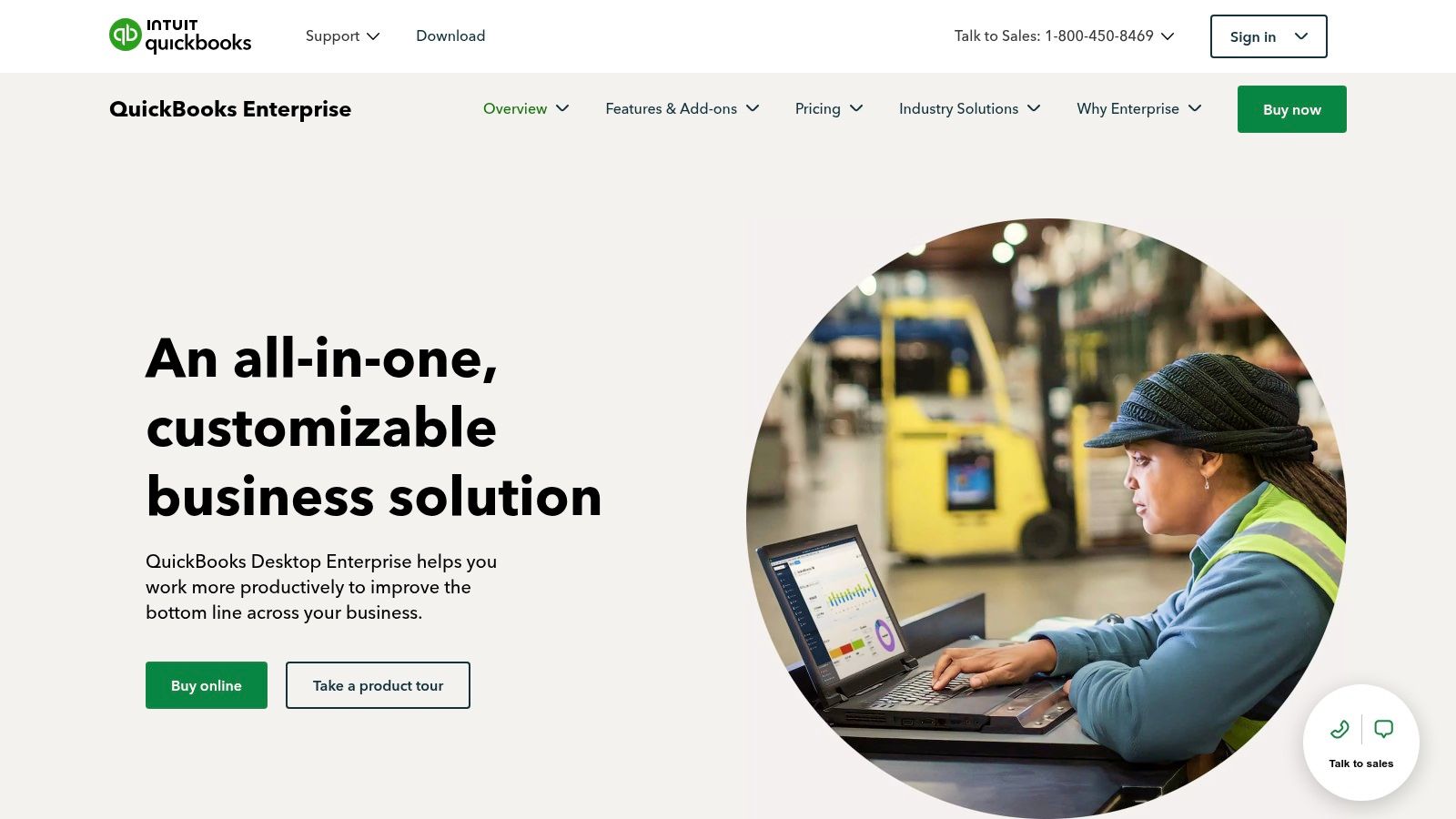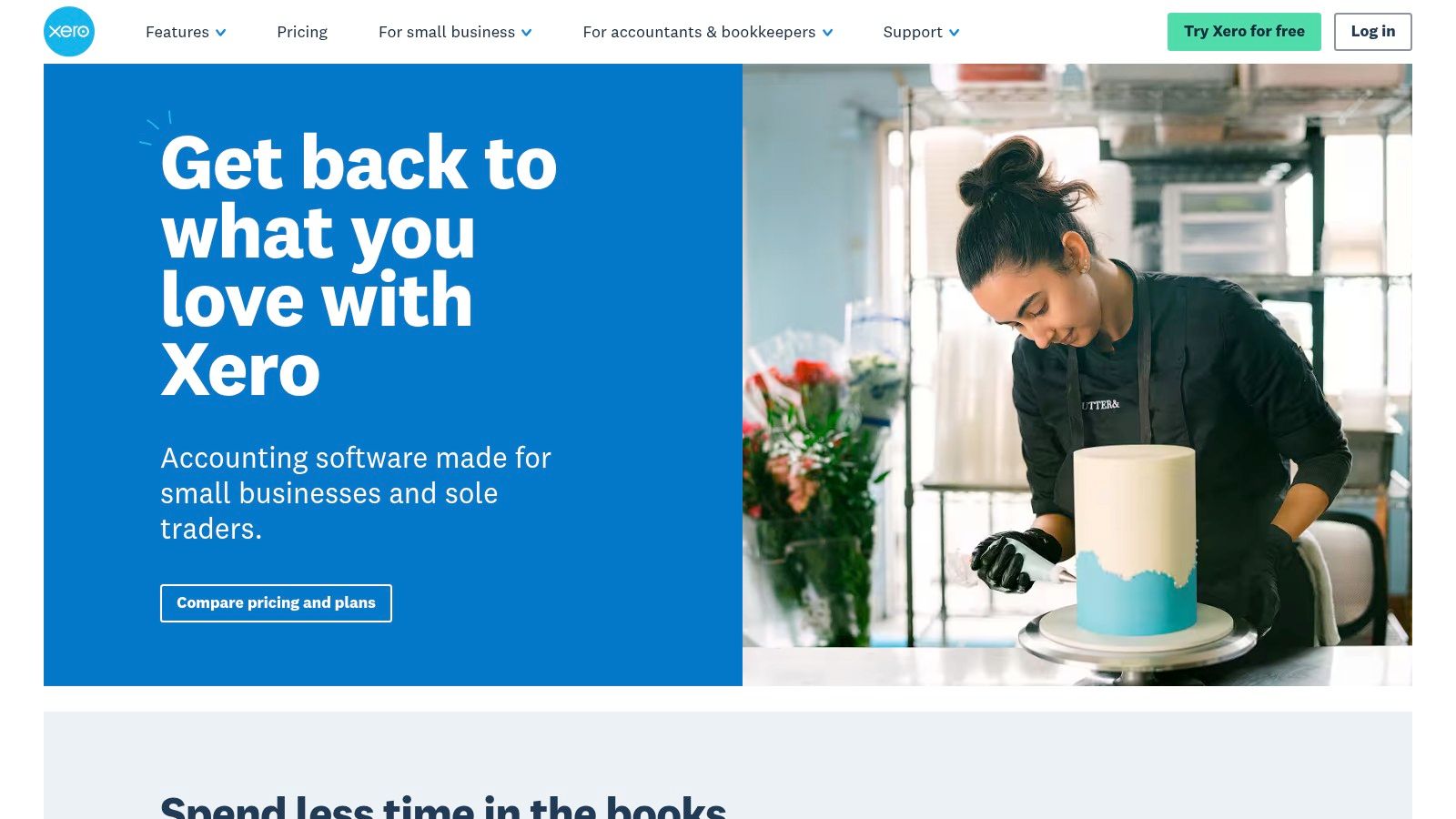Level Up Your Small Business With the Right ERP
Running a small business often feels like a juggling act. You're constantly managing inventory, finances, customer relationships, and streamlining operations. Dropping any one of these balls can have serious consequences. This is where Enterprise Resource Planning (ERP) software comes in. These powerful tools integrate various business processes into a single, unified system. This creates a centralized hub for everything from accounting and HR to supply chain management and customer service. Choosing the right ERP can eliminate data silos, automate tedious tasks, improve collaboration, and free you to focus on growing your business.
However, with so many ERP solutions available, finding the perfect fit for your small business can be overwhelming. How do you know which features are essential and which are unnecessary extras? What about pricing models, deployment options (cloud vs. on-premise), and integration capabilities with your existing software? And how can you ensure the system can scale with your business as it grows?
This article breaks down the top 10 ERP contenders for 2025, offering a comprehensive analysis of their strengths, weaknesses, pricing, and technical considerations. We will consider everything from robust, all-in-one platforms to more specialized solutions, catering to a variety of budgets and business needs. Whether you’re looking for high-tech features, streamlined efficiency, data-driven insights, or seamless accessibility, this guide will help you choose the right ERP system.
By the end, you'll have a clear understanding of the leading ERP options available. You'll also be well-equipped to select the system that will optimize your operations and unlock your business's full potential.
1. NetSuite ERP
NetSuite ERP, a robust cloud-based solution from Oracle, sits at the top of this list. Its comprehensive suite of applications is designed to streamline core business processes. While a powerful tool for enterprises, its scalability also makes it attractive for ambitious small businesses seeking a future-proof solution. Everything from financial management and inventory control to order management and CRM is housed within a single integrated platform.
For small businesses in high-growth mode, constantly switching or integrating new software can be a major resource drain. NetSuite addresses this by offering a unified platform that adapts to changing needs. Consider a rapidly expanding e-commerce business. NetSuite enables managing increasing inventory, tracking financial performance in real-time, and automating customer interactions, all without juggling separate software solutions.
Key Features and Benefits
-
Real-time Financial Management and Reporting: Gain immediate insight into your financial status with up-to-the-minute reporting, empowering data-driven decisions. This is essential for businesses needing accurate financial tracking for investors or rapid scaling.
-
Inventory and Supply Chain Management: Optimize inventory levels, streamline procurement, and automate fulfillment processes, minimizing carrying costs and preventing stockouts. This is especially useful for businesses with complex supply chains or variable demand.
-
Customer Relationship Management (CRM) Integration: Manage the entire customer lifecycle, from lead generation to post-sales support, within a single platform. This integration provides a 360-degree customer view, facilitating personalized marketing and enhanced customer satisfaction.
-
E-commerce Capabilities: NetSuite integrates seamlessly with e-commerce platforms, allowing for streamlined order processing, inventory synchronization, and revenue tracking. This is vital for online businesses.
-
Customizable Dashboards and Workflows: Tailor the system to your unique business requirements with customizable dashboards and automated workflows. This flexibility creates a system perfectly aligned with individual business processes.
Pros
- Highly Scalable: Grows alongside your business, minimizing future software migrations.
- Comprehensive All-in-One Solution: Streamlines operations and reduces dependence on multiple software systems.
- Strong Financial Management Features: Offers robust tools for financial planning, analysis, and reporting.
- Cloud-Based with Regular Updates: Ensures access to the latest features and security enhancements.
Cons
-
Higher Price Point: Can be a more expensive option compared to other small business ERP systems. Pricing is typically quote-based, depending on the modules and user count needed.
-
Implementation Can Be Complex: Requires careful planning and potentially specialized expertise. The implementation timeline can also be lengthy.
-
Extensive Feature Set: May offer more features than small businesses initially require, potentially overwhelming some users.
-
Steeper Learning Curve: Requires dedicated training to fully utilize the platform.
Implementation Tips
- Define Your Requirements: Identify the specific functionalities you need to avoid unnecessary costs.
- Consult an Expert: Partner with a certified NetSuite implementation consultant for a smoother process.
- Invest in Training: Ensure your team can effectively use the platform's features.
Website: https://www.netsuite.com/portal/products/erp.shtml
NetSuite ERP represents a significant investment, especially for smaller businesses. However, its comprehensive functionality, scalability, and potential for streamlining operations make it a powerful tool for companies with ambitious growth strategies. While the initial setup can be complex, the long-term advantages of a unified, future-proof ERP solution can outweigh the upfront costs and effort. It's best suited for businesses prioritizing long-term growth and efficiency and are willing to invest in a robust platform to reach those goals.
2. Odoo
Odoo stands out for its modular design, making it a highly adaptable ERP solution for small businesses. Unlike monolithic ERP systems, Odoo allows you to start with the core modules you need and seamlessly integrate additional functionalities as your business grows. This flexibility makes it particularly attractive for startups and rapidly scaling businesses.
Imagine launching an online store. You could start with Odoo's e-commerce and inventory management modules. As your customer base expands, you might add CRM (Customer Relationship Management) to manage customer interactions and marketing automation for targeted campaigns. Later, you could integrate accounting and project management modules for streamlined financial control and project execution. This modular approach prevents you from being overwhelmed by unnecessary features, allowing you to scale your ERP implementation with your business growth.
Odoo offers over 40 integrated business applications, covering everything from sales and marketing to manufacturing and human resources. This breadth of functionality rivals larger, more complex (and expensive) ERP systems, but with a focus on user-friendliness and a modern, intuitive interface. This makes Odoo accessible to a broader audience, including those without extensive technical expertise.
Features
- Modular system with 40+ business applications: Choose the modules relevant to your business needs, from CRM and accounting to inventory management and e-commerce.
- Available as open-source or enterprise edition: Opt for the free, community-driven open-source version or the enterprise edition for enhanced features and dedicated support.
- Intuitive user interface: Enjoy a user-friendly experience that minimizes the learning curve and increases user adoption.
- Integrated e-commerce platform: Seamlessly connect your online store with other business functions, such as inventory, sales, and customer relationship management.
- Comprehensive CRM functionality: Manage leads, track customer interactions, and automate marketing processes for improved customer engagement and sales.
Pros
- Flexible pricing with pay-per-module option: Only pay for the functionalities you use, making it a cost-effective solution.
- Start small and add modules as needed: Scale your ERP implementation alongside your business growth, avoiding unnecessary features and costs.
- Open-source version available for limited budgets: Leverage the free and community-driven open-source edition for a budget-friendly entry point.
- Modern and user-friendly interface: Enjoy a streamlined and intuitive user experience, even without a technical background.
Cons
- Open-source version requires technical expertise: Self-hosting and managing the open-source version requires significant technical knowledge and resources.
- Some modules may need customization: Tailoring specific modules to unique business requirements might involve additional development or configuration.
- Limited support on the community version: Rely on community forums and online resources for troubleshooting the open-source edition.
- Integration between modules sometimes requires configuration: While generally seamless, some inter-module integrations may require additional setup.
Implementation Tips
- Start with a needs assessment: Clearly define your current and future business requirements to determine the essential Odoo modules.
- Explore the free trial: Test drive the enterprise edition to evaluate the functionality and user interface before committing.
- Consider professional implementation services: For the open-source version or complex enterprise deployments, engaging Odoo partners for implementation and support can be beneficial.
Website: Odoo
Odoo's place on this list is solidified by its flexibility and modularity. It empowers small businesses to adopt ERP without the substantial upfront investment and complexity often associated with traditional ERP systems. Whether you're an entrepreneur, a business professional looking for streamlined operations, or a digital marketer seeking integrated e-commerce solutions, Odoo's adaptable nature and comprehensive features make it a compelling choice.
3. SAP Business One
SAP Business One is a robust ERP solution designed for small and medium-sized businesses (SMBs). While it requires a more significant investment than some basic options, it offers scalability and the reliability of SAP, a leader in enterprise software. This makes it a good choice for growing businesses that need a system that can expand along with them.
SAP Business One integrates essential business functions within a single platform.
Key Features of SAP Business One
Let's take a closer look at some of its core functionalities:
-
Financial Management: Handle all your financial processes, from general ledger and accounts payable/receivable to fixed assets and banking. This streamlines operations and offers real-time financial insights.
-
Sales and Customer Relationship Management (CRM): Track leads, manage customer interactions, process orders, and analyze sales data to improve customer relationships and boost revenue. The built-in CRM features enable personalized service and targeted marketing.
-
Purchasing and Inventory Control: Optimize procurement, efficiently manage stock, and minimize carrying costs with comprehensive inventory control tools. This is especially helpful for businesses with complex supply chains or varying demand.
-
Business Intelligence and Reporting: Gain valuable insights into your business performance through robust reporting and analytics. Monitor key performance indicators (KPIs), identify trends, and make informed, data-driven decisions.
SAP Business One offers both on-premises and cloud deployment options, providing flexibility for businesses. Cloud deployment can reduce initial IT infrastructure costs and simplify maintenance. Pricing is typically subscription-based, depending on the number of users and modules selected, but it's not publicly available. Implementation usually requires assistance from an SAP partner, which adds to the initial cost.
Pros and Cons of SAP Business One
Here's a quick overview of the advantages and disadvantages:
Pros:
- Reliability and scalability due to SAP's enterprise technology.
- Comprehensive functionality within a single platform, avoiding the need for multiple systems.
- Strong inventory and production planning capabilities, beneficial for manufacturing and distribution businesses.
- Adapts to business growth and increasing complexity.
Cons:
- Higher initial investment compared to some competitors, potentially challenging for very small businesses or startups.
- Implementation often requires partner assistance, which can increase costs and implementation time.
- The interface may appear less modern than some newer solutions.
- Customization can be complex and expensive.
For businesses looking for a comprehensive, scalable solution from a reputable provider, SAP Business One is a strong option. You might be interested in: Our guide on sitemaps for more resources on software selection.
Visit the SAP Business One Website
4. Zoho Books
Zoho Books offers a robust and affordable entry point for businesses seeking streamlined management. While not a complete ERP system on its own, its comprehensive accounting features and integration with other Zoho applications make it attractive for small businesses, especially those already using Zoho's suite of products. It effectively bridges the gap between basic accounting software and a full ERP, providing a scalable solution that can grow with your business.
Zoho Books shines in its automation of core financial tasks. Features like automated invoice generation, online payment processing, and recurring expense tracking save valuable time for business owners. This allows them to focus on strategic initiatives rather than manual data entry. The user-friendly interface requires minimal training, making it easy to use, even for those without an accounting background. This ease of use is a significant benefit for small businesses with limited resources.
For tech-savvy users, digital marketers, remote workers, or anyone managing their own finances, Zoho Books' mobile apps provide convenient access to financial data. Users can reconcile expenses, approve invoices, or check cash flow directly from their phones, regardless of location.
Key Features and Benefits
- End-to-End Accounting and Tax Compliance: Manage everything from basic bookkeeping to complex tax calculations all in one platform.
- Inventory Management: Track stock levels, manage orders, and automate reordering processes. While suitable for many small businesses, it may have limitations for those with highly complex inventory needs.
- Project Time Tracking and Billing: Monitor project progress, track billable hours, and generate accurate invoices. This is especially useful for service-based businesses.
- Client Portal: Improve customer collaboration by providing clients secure access to invoices, payments, and project status updates.
- Extensive Zoho Integration: Connect seamlessly with other Zoho applications like CRM, Inventory, and Projects to create a more comprehensive system.
Pros
- Affordable Pricing: Zoho Books offers competitive pricing plans tailored for small businesses.
- User-Friendly Interface: Minimal training and onboarding are required.
- Mobile Apps: Access and manage finances from anywhere.
- Robust Automation: Streamlines essential accounting tasks.
Cons
- Not a Full ERP: Requires additional Zoho products for full ERP functionality, which can increase complexity and cost.
- Limited Manufacturing Capabilities: May not be suitable for businesses with complex manufacturing processes.
- Inventory Management Limitations: Businesses with complex inventory needs may require a more robust solution.
- Advanced Features in Higher Tiers: Some advanced features are only available in higher-priced plans.
Website: https://www.zoho.com/books/
Implementation Tip
Start with a free trial to explore Zoho Books' features and assess its suitability for your business. If you already use other Zoho products, investigate the integration options to enhance efficiency. Consider consulting a Zoho partner for implementation and customization support, especially if you plan to integrate multiple Zoho applications. Explore the website for current pricing based on your specific needs. System requirements are generally minimal since Zoho Books is a cloud-based solution accessible through a web browser and mobile apps.
5. Acumatica Cloud ERP
Acumatica Cloud ERP stands out for its flexible, consumption-based pricing and comprehensive features designed for expanding businesses. Unlike traditional ERP systems with per-user fees, Acumatica's pricing scales with your resource consumption. This makes it a budget-friendly option for smaller companies needing wide system access without the high cost.
This pricing structure is especially advantageous for rapidly growing companies or those with many employees requiring ERP access. Acumatica consolidates essential business functions, from financial management and accounting to distribution management and CRM. This centralized platform streamlines operations and boosts overall efficiency.
Its robust project accounting capabilities are particularly beneficial for project-based businesses. These features allow for detailed tracking of project costs, timelines, and profitability. Furthermore, Acumatica offers specialized editions for industries like construction, manufacturing, and retail, demonstrating its versatility across various business sectors.
Key Features and Benefits
Acumatica offers a wide range of features to support diverse business needs:
- Usage-based pricing: You pay only for the resources you consume, not for the number of users. This creates a predictable and scalable expense, unlike per-user pricing models that can become costly with team growth.
- Financial management and accounting: Automate essential accounting tasks, gain clearer financial insights, and generate precise reports.
- Distribution management and CRM: Manage sales, inventory, and customer interactions seamlessly within a single platform.
- Project accounting capabilities: Maintain detailed oversight of project budgets, resources, and schedules.
- Industry-specific editions: Benefit from pre-built functionalities and industry best practices with tailored solutions.
- Strong mobile access and responsive design: Access crucial data and manage your business from anywhere at any time.
- Customizable dashboards and workflows: Adapt the system to your specific needs and streamline business processes.
- Open API architecture for integrations: Connect effortlessly with other business applications and extend Acumatica's capabilities.
Pros and Cons
While Acumatica offers compelling advantages, it's crucial to consider potential drawbacks:
Pros:
- Flexible pricing model ideal for growing businesses: The consumption-based pricing facilitates scaling without escalating license costs.
- Strong mobile access and responsive design: Supports remote work and allows for real-time decision-making.
- Customizable dashboards and workflows: Allows businesses to tailor the system to their unique operational needs.
- Open API architecture for integrations: Ensures compatibility with existing software.
Cons:
- Implementation typically requires partner assistance: While beneficial for tailored setup, this can increase initial implementation expenses.
- May require more IT resources than some simpler solutions: Managing the robust feature set may require greater technical expertise.
- Some users report steep learning curve: Adequate training and onboarding are essential for maximizing the platform's potential.
- Newer platform with smaller community compared to established options: While growing, readily available support resources might sometimes be harder to find.
Implementation/Setup Tips
For a successful Acumatica implementation:
- Partner with a Certified Acumatica Partner: Leverage their expertise for guidance through setup, customization, and training.
- Define Your Business Requirements: Clearly outlining your business needs and processes beforehand ensures a customized solution.
- Invest in User Training: Maximize user adoption and proficiency through thorough training.
Website: Acumatica Cloud ERP Software
Acumatica is a robust cloud ERP solution designed for business growth. Its unique pricing and broad functionality make it a worthwhile investment for businesses seeking to streamline operations and scale efficiently. However, consider the potential learning curve and implementation complexity during your decision-making process.
6. Microsoft Dynamics 365 Business Central
Microsoft Dynamics 365 Business Central is a robust, scalable ERP solution designed for growing small to mid-sized businesses. While it's more expensive than basic accounting software, its comprehensive features and integration with the Microsoft ecosystem make it a powerful tool for streamlining operations and gaining valuable business insights.
This ERP solution connects financials, sales, service, and operations data, providing a unified view of your business. Imagine having real-time inventory visibility while processing sales orders, or automatically generating financial reports directly from your operational data. This interconnectedness empowers businesses to make informed decisions and improve customer interactions.
Key Features and Benefits
-
Financial Management and Accounting: Manage your entire financial landscape, from general ledger and accounts payable/receivable to fixed assets and cash flow forecasting. Business Central provides the tools for accurate financial reporting and analysis.
-
Supply Chain, Inventory, and Warehouse Management: Gain control over your inventory with real-time tracking, automated replenishment, and streamlined warehouse processes. Optimize your supply chain for efficiency and cost savings.
-
Native Integration with Microsoft Products: Seamlessly integrate with familiar tools like Microsoft Office 365 (Outlook, Excel, Teams) and Power BI for enhanced collaboration, reporting, and data analysis. Imagine pulling financial data directly into Excel for custom reports or collaborating on sales forecasts within Teams.
-
AI-Powered Insights and Reporting: Use AI-driven insights to identify trends, predict outcomes, and make data-driven decisions. Business Central can provide predictive analytics for sales forecasting or identify potential bottlenecks in your supply chain.
-
Customizable with Power Platform: Tailor Business Central to your specific needs using the Microsoft Power Platform (Power Apps, Power Automate, Power BI). Create custom workflows, automate tasks, and build tailored applications without extensive coding.
Pros
-
Familiar Microsoft Interface: Reduces training time and increases user adoption with its intuitive, Microsoft-centric design.
-
Strong Integration with Office 365 and Power BI: Streamlines data sharing and reporting, leveraging tools your team likely already uses.
-
Scales from Small to Mid-Sized Operations Effectively: Adapts to your business growth, ensuring a long-term solution.
-
Cloud-Based with Regular Automatic Updates: Benefits from the latest features and security updates without manual upgrades.
Cons
-
Higher Price Point Than Entry-Level Accounting Software: May not be budget-friendly for very small businesses with basic needs.
-
Some Customizations Require Partner Assistance: While the Power Platform offers extensive customization, complex modifications might require a Microsoft partner's expertise.
-
Implementation Can Be Complex for Full Feature Utilization: Requires careful planning and potentially professional assistance to maximize its potential.
-
May Have Unnecessary Features for Very Small Businesses: Smaller businesses might find some of the advanced functionalities redundant.
Pricing and Technical Requirements
Microsoft Dynamics 365 Business Central pricing is subscription-based and depends on the number of users and required features. Contact Microsoft or a certified partner for details. As a cloud-based solution, Business Central primarily requires a stable internet connection and a compatible web browser. Specific requirements for integrations and customizations may vary.
Implementation Tips
-
Clearly Define Your Business Needs: Before implementation, identify your core requirements and pain points to ensure Business Central addresses them effectively.
-
Engage a Certified Partner: Consider partnering with a certified Microsoft Dynamics 365 partner for implementation, training, and ongoing support.
-
Phased Rollout: Implement Business Central in phases, focusing on critical functionalities first, to minimize disruption and facilitate user adoption.
-
Invest in Training: Proper training is crucial for maximizing user adoption and realizing the platform’s full potential.
Microsoft Dynamics 365 Business Central offers a powerful, integrated solution for businesses ready to move beyond basic accounting software. While it's a more significant investment, its comprehensive features, scalability, and Microsoft ecosystem integration make it a valuable asset for growing businesses.
7. ERPNext
ERPNext is a powerful open-source ERP solution designed for small and medium-sized businesses. Its suite of modules covers everything from accounting and inventory management to sales, purchasing, manufacturing, and HR. This makes it a versatile tool for managing various aspects of your business operations. Its flexibility, affordability, and active community support have earned it a spot on our list.
One of ERPNext's key strengths is its open-source nature. This means no per-user licensing fees for the self-hosted version, making it a cost-effective choice. You're free to modify the source code to fit your specific needs, offering a level of customization not often found in commercial ERP solutions. Cloud-hosted options are also available for businesses preferring a simpler setup, although these come with a fee.
ERPNext features a modern and intuitive interface, designed for ease of use. Integrated accounting, streamlined inventory tracking, and efficient sales order processing can significantly improve your operational efficiency. For example, a small manufacturing business can use ERPNext to manage its entire production process, from tracking raw materials to managing finished goods and sales orders. Service-based businesses can use it for project management, time tracking, and invoicing.
While the open-source version is free, implementing ERPNext can require technical expertise, particularly for self-hosting. It may not be as polished as some commercial ERP alternatives, and professional support is limited unless you choose the paid, hosted version. It also has fewer third-party integrations compared to some commercial ERP systems. For more tools and resources, see Our PickAlternative Sitemap.
Features:
- Completely free open-source version available
- Comprehensive modules covering all core business functions
- User-friendly interface with minimal training required
- Self-hosted or cloud-hosted options
- Active community for support and development
Pros:
- No per-user licensing fees with the open-source version
- Regular updates and improvements from the community
- Highly customizable to specific business needs
- Clean, modern interface
Cons:
- Requires technical expertise for implementation
- Less polished than commercial alternatives
- Limited professional support for the free version
- Fewer third-party integrations compared to commercial options
Website: https://erpnext.com/
In summary, ERPNext offers exceptional value for small businesses willing to invest the time and effort required for implementation. Its open-source nature, comprehensive features, and active community make it a strong alternative to expensive commercial ERP solutions.
8. QuickBooks Enterprise
QuickBooks Enterprise is a powerful solution for small businesses that have outgrown basic accounting software but aren't ready for a complex ERP system. It bridges the gap by offering advanced features like robust reporting and advanced inventory management within a familiar QuickBooks environment.
This makes it an attractive option for businesses already working with QuickBooks products. It minimizes the learning curve and allows for a smoother transition. Consider a small retail business with multiple locations and an expanding product catalog, or a service company managing numerous field teams and projects. QuickBooks Enterprise can offer the needed control and insights without the complexity and cost of full-blown ERP solutions.
Key Features and Benefits
- Advanced Inventory Management: Move beyond basic tracking with features like FIFO and LIFO costing, barcoding, and serial/lot number tracking. This helps ensure accurate inventory valuation, streamlines order fulfillment, and minimizes stockouts.
- Industry-Specific Editions: QuickBooks Enterprise provides tailored versions for contractors, manufacturers, wholesalers, and retailers. Each offers specialized functionality for the specific sector. For example, the contractor edition includes tools for job costing and project management.
- Scalability: The software supports up to 40 simultaneous users, accommodating business growth.
- Enhanced Reporting and Business Analytics: Gain deeper insights into your financials with customizable reports on sales, expenses, and inventory. These reports inform strategic decision-making and identify areas for improvement.
- Flexible Deployment: Choose between on-premises or hosted cloud deployment options to meet your IT infrastructure and security requirements.
Pros
- Familiar Interface: Current QuickBooks users will adapt quickly, minimizing training time and increasing productivity.
- Lower Learning Curve: Compared to full ERP systems, QuickBooks Enterprise is easier to learn and implement.
- Strong Accounting Foundation: Built on the trusted QuickBooks accounting engine, ensuring accurate and reliable financial data.
- Large User Community and Abundant Support Resources: Benefit from a large user community and readily available support documentation and assistance.
Cons
- Not a True End-to-End ERP Solution: QuickBooks Enterprise lacks some of the advanced features of full ERP systems, like comprehensive manufacturing management or sophisticated supply chain planning.
- Limited Manufacturing Capabilities: While suitable for light manufacturing, the software may not be sufficient for more complex manufacturing processes.
- Less Customizable than Dedicated ERP Systems: Customization options are less extensive compared to full-fledged ERP systems.
- May Become Constraining as Business Grows Significantly: Rapidly expanding businesses may eventually outgrow QuickBooks Enterprise and need a more comprehensive ERP system down the line.
Pricing and Technical Requirements
Pricing for QuickBooks Enterprise is based on the number of users and features selected. Contact QuickBooks directly or an authorized reseller for detailed pricing. System requirements vary based on deployment (desktop or cloud). See the QuickBooks Enterprise website for specifics.
Implementation Tips
- Data Migration: Careful planning of your data migration from existing systems ensures a smoother transition.
- Training: While the interface is familiar to QuickBooks users, training on the advanced features is crucial for successful implementation.
- Customization: Explore available customization options to tailor the software to your specific business processes.
QuickBooks Enterprise is a viable ERP-like solution for small businesses that need more than basic accounting software but aren't ready for a full ERP implementation. Its familiar interface, strong accounting core, and advanced features make it a valuable tool for managing growth and improving control over key business processes. However, rapidly growing businesses should be aware of its limitations and plan for a possible transition to a more comprehensive ERP system in the future.
9. Sage 300cloud
Sage 300cloud (formerly Sage Accpac) is a robust mid-market Enterprise Resource Planning (ERP) solution. It bridges the gap between basic accounting software and complex enterprise systems, making it a viable option for growing small to medium-sized businesses. While it caters to a wide range of industries, it's particularly well-suited for companies with multiple locations, international operations, or complex inventory management needs. Its mature feature set, strong international capabilities, and flexible deployment options secure its place on this list.
Sage 300cloud is not entry-level accounting software. It's designed for businesses that have outgrown basic tools and need a more comprehensive system to manage their finances, operations, and inventory. Think distributors, manufacturers, and international businesses dealing with multiple currencies and complex tax regulations. It's also a good fit for businesses anticipating significant growth and requiring a scalable solution.
Key Features and Benefits
-
Multi-company and Multi-currency Financial Management: Manage finances across multiple subsidiaries, countries, and currencies with ease. This is invaluable for businesses with international operations or complex organizational structures.
-
Robust Inventory Management and Warehousing: Gain real-time visibility into your inventory levels, track stock movements across multiple warehouses, and optimize your supply chain.
-
Streamlined Order Processing and Purchasing: Automate sales orders, purchase orders, and invoicing, reducing manual errors and improving efficiency.
-
Project and Job Costing: Track project expenses, budgets, and profitability to ensure projects stay on track and within budget.
-
Flexible Deployment: Choose between cloud or on-premises deployment to suit your IT infrastructure and business needs. Cloud deployment offers accessibility and scalability, while on-premises provides greater control over data and customization.
Pros
-
Strong International Business Capabilities: Excellent support for multiple languages, currencies, and international accounting standards.
-
Extensive Third-Party Add-ons: A large ecosystem of add-ons allows you to tailor the system to specific industry or business needs.
-
Modular Approach: Start with essential modules and add more as your business grows, minimizing initial investment and maximizing ROI.
-
Established Product with a Large User Base: Benefit from a mature product with a wealth of resources, support, and community knowledge.
Cons
-
Interface Feels Less Modern: The interface may feel dated and less intuitive compared to some newer cloud ERP solutions.
-
Implementation Often Requires Partner Assistance: While partner assistance can ensure a smooth implementation, it can also add to the overall cost.
-
Higher Initial Investment Than Entry-Level Solutions: This is expected for a mid-market ERP system with a broader feature set.
-
Some Users Report Limited Reporting Capabilities: While generally sufficient, some users find the reporting functionality less flexible than desired.
Pricing and Technical Requirements
Sage 300cloud pricing is quote-based and depends on the specific modules selected, the number of users, and the deployment option (cloud or on-premises). Contact Sage or a certified partner for a personalized quote. Technical requirements vary based on the chosen deployment method.
Implementation/Setup Tips
-
Engage a Certified Partner: A Sage partner's expertise is crucial for successful implementation, customization, and training.
-
Clearly Define Your Needs: Thoroughly assess your business requirements to choose the right modules and avoid unnecessary expenses.
-
Data Migration Planning: Proper planning is essential for a smooth data migration from existing systems.
-
User Training: Invest in comprehensive user training to maximize adoption and realize the system's full potential.
Comparison with Similar Tools
Sage 300cloud occupies a middle ground between entry-level solutions like QuickBooks Online and enterprise-level systems like SAP. Compared to QuickBooks, it offers more advanced features and scalability. Compared to SAP, it's more affordable and easier to implement. Other comparable solutions include Microsoft Dynamics GP and NetSuite.
Website
Sage 300cloud empowers growing businesses to manage their complex operations efficiently. While it might not be the most modern-looking solution, its depth of functionality, flexibility, and international capabilities make it a strong contender for businesses looking to upgrade their ERP system.
10. Xero
Xero is a great entry-level ERP solution for very small businesses, especially those in service industries. While known for its accounting software, Xero offers an extensive app marketplace that expands its functionality, creating a lightweight ERP system. This allows businesses to begin with core accounting at an affordable price and scale up by adding integrations as needed.
Imagine a small digital marketing agency managing various client projects. Xero lets them track project time, manage expenses, and invoice, all within one platform. As they grow, they could integrate project management tools, CRM systems, and even inventory management solutions if they begin selling physical goods. This flexibility makes Xero ideal for growing businesses.
Key Features and Benefits
Key features include cloud-based financial and accounting management, inventory tracking, project time tracking and management, multi-currency support, and over 800 third-party app integrations. This extensive marketplace elevates Xero from basic accounting software to a customizable ERP.
Pros:
- Affordable Pricing: Xero's starter plans are designed for small businesses with limited budgets.
- User-Friendly Interface: Even those without accounting expertise can easily navigate the system.
- Mobile Apps: Manage finances from anywhere, perfect for remote workers or frequent travelers.
- Regular Updates: Xero consistently adds new features and improvements.
Cons:
- Not a Full ERP: Third-party apps are required for complete ERP functionality, which can become complex.
- Limited Manufacturing: Businesses with intricate manufacturing processes may need a more specialized ERP.
- Integration Costs: Adding multiple integrations can increase overall expenses.
- Scalability Challenges: Xero's reliance on integrations may become difficult to manage for larger businesses.
You might be interested in: Our PickAlternative Sitemap for more relevant business tools and resources.
Website and Pricing
Website: Xero
While pricing varies depending on the plan and integrations, Xero offers competitive starting prices for small businesses. Remember to include the cost of essential integrations in your budget. Because Xero is cloud-based, the technical requirements are minimal; you just need an internet connection. Implementation is typically simple, thanks to the user-friendly interface. Consider consulting a Xero advisor or using online resources for a smoother setup and to maximize the platform's potential for your specific needs.
Top 10 Small Business ERP Comparison Matrix
| Product | Core Features ★ | User Experience ★ | Unique Selling Points ✨ | Target Audience 👥 | Pricing 💰 |
|---|---|---|---|---|---|
| NetSuite ERP | Cloud-based finance, inventory & CRM | Powerful yet steeper learning curve | All-in-one suite; high scalability | Growing small businesses | Premium |
| Odoo | Modular ERP with 40+ apps & open-source option | Intuitive and flexible | Pay-per-module; highly customizable | Start-ups to SMEs | Flexible & affordable |
| SAP Business One | Integrated finance, sales & inventory management | Robust SAP technology; some dated interface | Enterprise-grade solution for SMEs | Small to medium businesses | Moderate-to-high |
| Zoho Books | Comprehensive accounting, inventory & project billing | User-friendly; minimal training required | Seamless Zoho app integration | Budget-focused small businesses | Very affordable |
| Acumatica Cloud ERP | Cloud ERP covering finance, distribution & projects | Responsive with strong mobile support | Unique usage-based pricing model | Growing multi-user businesses | Cost-effective & flexible |
| Microsoft Dynamics 365 Business Central | Finance, supply chain, AI-powered insights & reporting | Intuitive; deep Microsoft integration | Seamless Office 365 & Power Platform integration | SMBs in the Microsoft ecosystem | Higher investment |
| ERPNext | Open-source ERP covering finance to HR | Clean interface; requires technical setup | Free version and high customization capability | Budget-conscious SMEs | Cost-effective (free option) |
| QuickBooks Enterprise | Advanced accounting, inventory & reporting | Familiar QuickBooks interface | Enterprise power with ease of use | Growing businesses & accountants | Moderate-to-high |
| Sage 300cloud | Financials, inventory with multi-currency support | Modular but older interface | Strong international capabilities & add-ons | Multi-location SMEs | Higher initial investment |
| Xero | Cloud-based finance, inventory & extensive app integrations | Exceptionally user-friendly | Vast third-party app marketplace | Very small businesses | Affordable with add-on costs |
Ready to Choose Your Perfect ERP?
Finding the right ERP software is a crucial investment in your small business's future. We hope this list featuring NetSuite ERP, Odoo, SAP Business One, Zoho Books, Acumatica Cloud ERP, Microsoft Dynamics 365 Business Central, ERPNext, QuickBooks Enterprise, Sage 300cloud, and Xero has helped you narrow down your options. But how do you make that final decision?
Choosing between these powerful tools requires careful consideration. Begin by revisiting your specific business needs. Which software best aligns with your current workflows and plans for growth? Does your business prioritize inventory management, financial reporting, customer relationship management (CRM), or a combination of these functionalities? Refer back to the features highlighted for each ERP and compare them with your prioritized list.
Once you’ve identified a few top contenders, delve deeper into implementation and getting started. Some platforms offer comprehensive onboarding programs and detailed documentation, while others might require more technical expertise or the assistance of third-party consultants. Consider the time and resources you have available for implementation, and factor this into your final decision. A smooth, efficient implementation process is crucial for minimizing disruption to your day-to-day business operations.
Budget is, of course, a primary concern for any business. While some ERP solutions offer subscription-based pricing, others involve upfront licensing fees. Think beyond the initial cost and consider the potential long-term expenses, such as maintenance, upgrades, and customization. Don’t forget to factor in the potential return on investment (ROI) that a well-implemented ERP can provide. This can come through improved efficiency, reduced errors, and enhanced decision-making.
Integration and compatibility are also key factors to consider when selecting an ERP. Does the ERP integrate seamlessly with your existing software? This might include your CRM, e-commerce platform, or marketing automation tools. Check for API access and compatibility with your current operating systems and hardware. A well-integrated system can streamline data flow, eliminate data silos, and lead to better insights and more informed business decisions.
Key Takeaways
-
Prioritize Your Needs: Focus on the features and functions most critical for your specific business requirements.
-
Consider Implementation: Evaluate the ease of setup, training, and the availability of ongoing support.
-
Budget Realistically: Factor in both upfront and long-term costs, while also considering the potential ROI.
-
Ensure Compatibility: Confirm integration capabilities with your existing systems and infrastructure.
Choosing the right ERP can significantly impact your small business’s efficiency, productivity, and profitability. By carefully considering your needs, budget, and long-term goals, and using the information provided in this list, you can make an informed decision and select the ERP solution that best positions your business for success.




